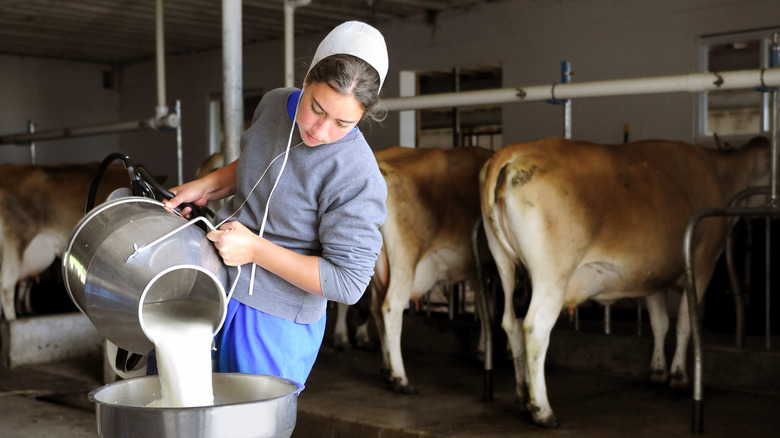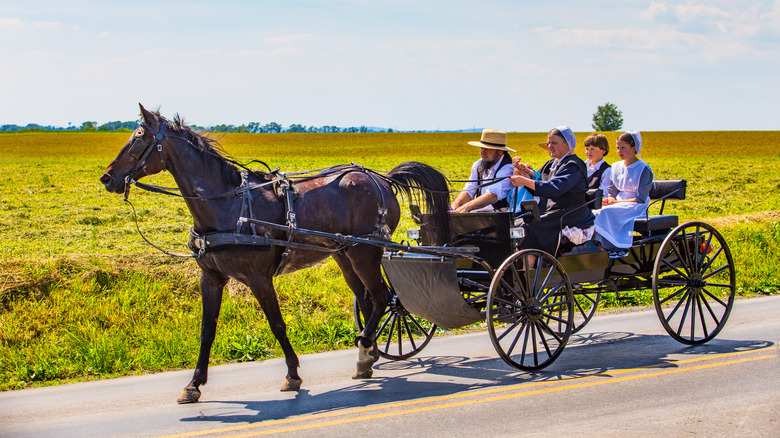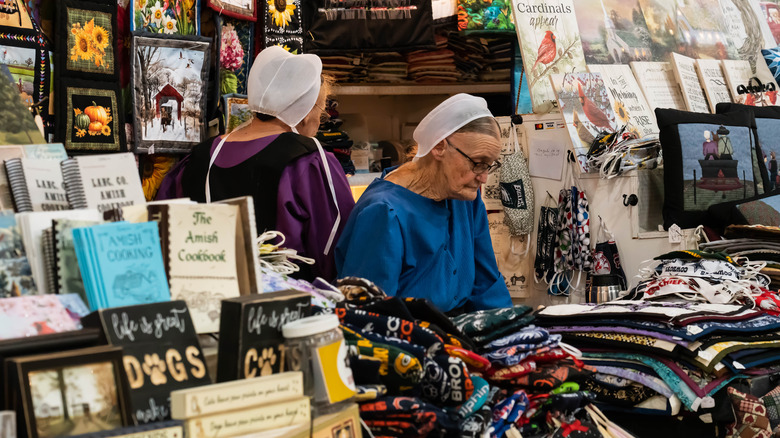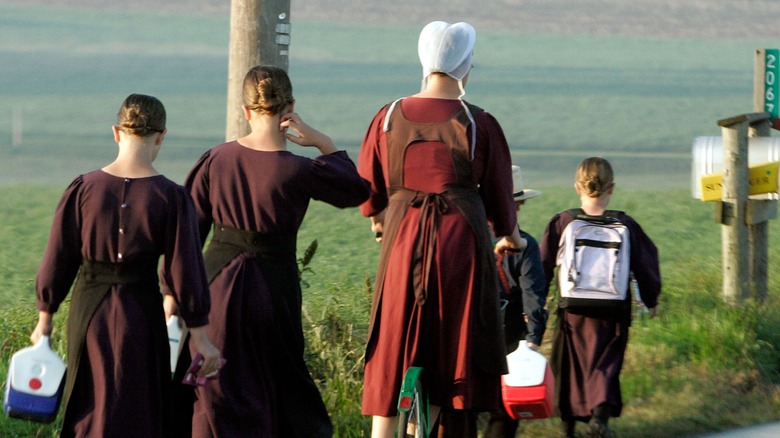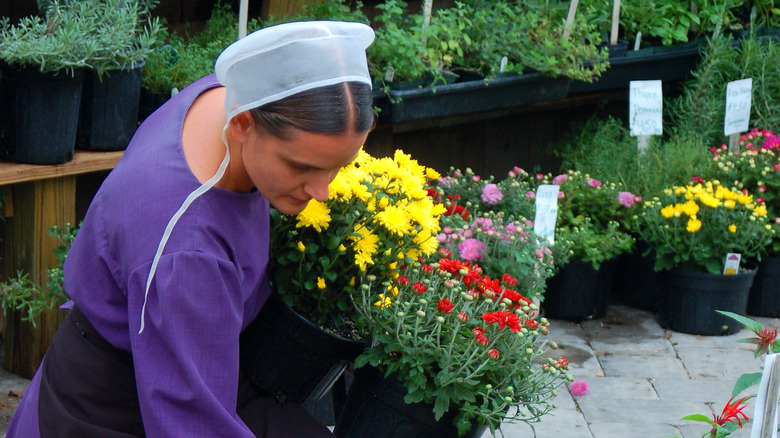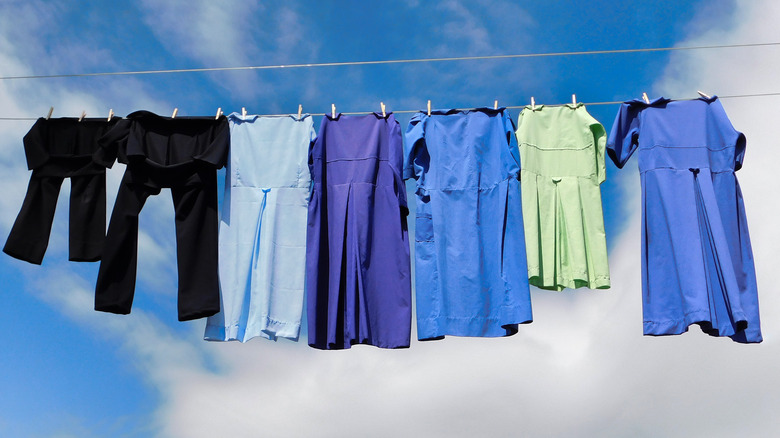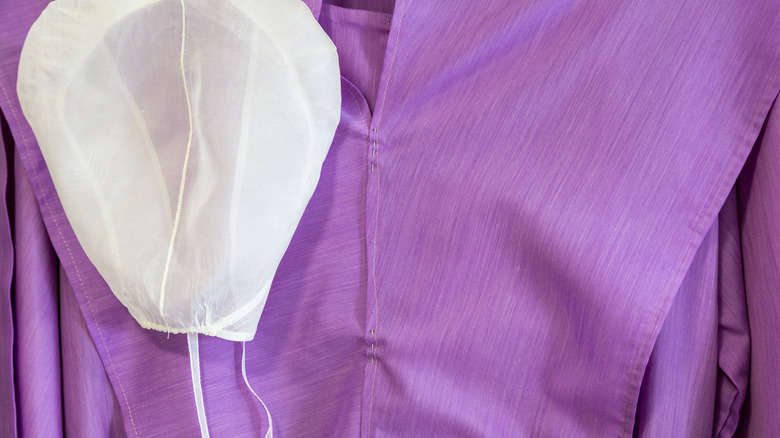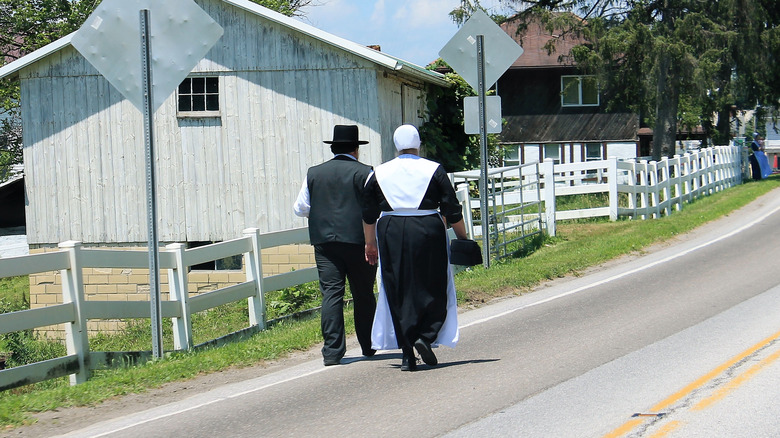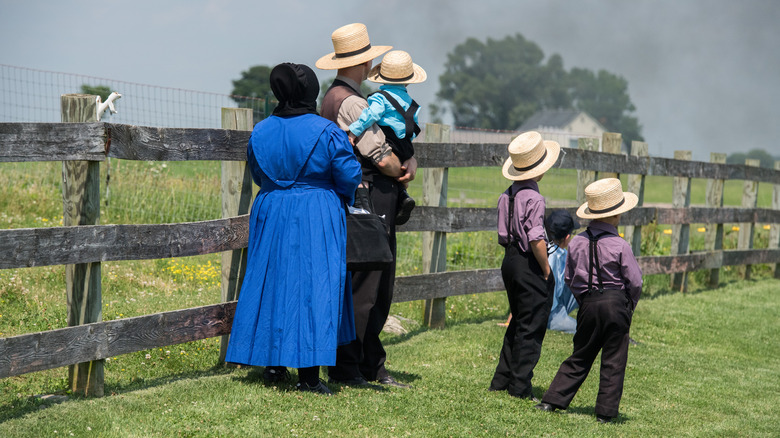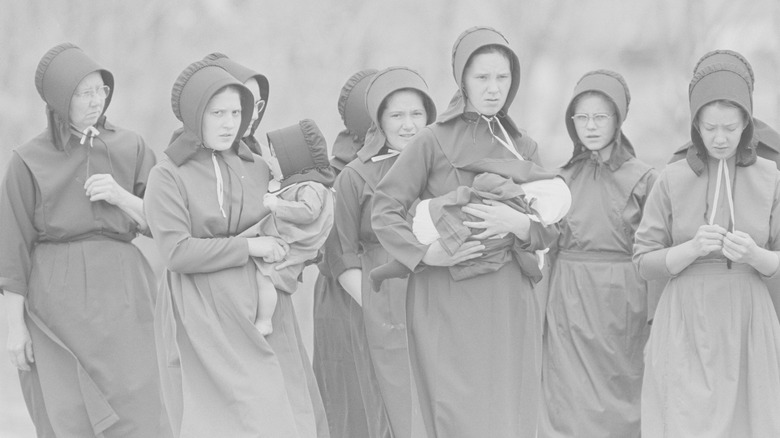Unexpected Rules Amish Women Have To Follow
There's little use in talking about the Amish, much less Amish women, as if they are all members of a single, monolithic group. The reality is that there are multiple orders of Amish, all with different rules collected in a broad set of often-unspoken guidelines known as the Ordnung. These rules dictate the lives of everyone in the Amish faith, laying out community-specific guidelines on everything from the depth of a man's hat brim to whether or not it's okay to have a refrigerator in one's home.
Generally speaking, all Amish settlements emphasize plain, unadorned dress styles, rural living, pacifism, and some separation from the outside world — and no, they're not the same as Mennonites. When it comes to both community and family life, women are almost always expected to be subservient to men. Yet they also take the lead on many homemaking matters, including child rearing, food preparation, cleaning, and working on the farm.
So, it all seems rather simple. Amish women are expected to observe rules that demand they remain subservient, wear plain clothing, and remember to be faithful and modest. However, those directives can get quite surprising and sometimes elaborate, depending on where a woman lives and her personal convictions. For instance, it wouldn't be beyond the pale to see an Amish woman leave the family farm and run her own business. Think you already know everything about the rules of an Amish woman's life? Think again.
The rules of Amish female power are more complex than you think
Being submissive is a common rule for Amish women, but it's not just a matter of going along with a husband's decisions or quietly following the rules of male church elders. In fact, all Amish people are expected to submit in one way or another. Men are directed to submit to God and to treat their wives well and care for them with love and respect (though there are also reports of widespread abuse in some communities). There's also a rather tricky verse in Galatians 3:28, in which readers are informed that "there is neither male nor female: for ye are all one in Christ Jesus." To balance this, the Amish generally agree that men and women ought to have separate roles in their communities but that the work done by women is theoretically just as important as that of the men. And though Amish women may not have official power in their communities, they wield practical power in everyday life, such as when they organize home or church activities.
Everyone is responsible for their own spiritual life, too. As one woman in the highly conservative Swartzentruber Amish group states, "The Amish way is that the men have to go ahead of the women [during baptism], but the women get baptized just as well as the men do" (via Karen M. Johnson-Weiner's "The Lives of Amish Women").
An Amish woman's name can be linked to a man's in more ways than one
For many Americans who receive a name at birth, that name will inevitably be linked to the father's family name. While those trends are changing — and you could argue that a woman takes ownership of a name once it's been granted to her — this patriarchal naming system is still the norm in many communities. That holds true for Amish women as well, but with additional social rules that make it more unexpected.
According to Saloma Miller Furlong, who grew up in an Ohio Amish community, it often starts with shared names. In a small community with criss-crossing family lines, such as the Amish, people who share the same first and last names meet all the time. To distinguish her from other women named Saloma, Furlong was often referred to as "Sim's Lomie" — "Sim" being a nickname for her father, Simon, and "Lomie" being a diminutive form of Saloma. Once she was married, she would have been referred to via her husband's name as David Saloma (though Furlong left the Amish and married out of the group). Rarely, Furlong reported, a wife's name might be used to identify her husband if he had a long line of similar names in his own family. And a father's name would be used in its plural form to reference his whole family; for instance, young Saloma Miller's family unit would have simply been known as "Simons."
Rules about working outside the home can be murky
Some sources definitively state that Amish women are expected to stay at home and take on duties associated with raising children and running a household. That's respectable work, to be sure, but a more clear-eyed look at the diverse array of Amish groups shows that not every woman must follow that rule. Even women from more conservative communities may work outside the home as employees of a larger business or as entrepreneurs. However, the rules they must follow to be in business and still adhere to the guidelines of their community can make things complicated.
Much like men in their community, working Amish women must decide — sometimes with quite a bit of communal fretting — whether or not it's okay to use technology like phones or a computer with internet access. As one business owner admitted, her use of electronics made her feel guilty and induced worry that other Amish might start to complain about her borderline worldliness. But another boldly stated that church leaders should stay out of it. "[If] they have a problem with my business," she said, "well, that's their problem, not mine" (via "The Lives of Amish Women").
Even if they're situated solidly within the community and have little contact with outsiders, young women might still earn a wage working for fellow Amish business owners or as school teachers (though they are often low-paid and their salaries go directly to their families).
Hair covering rules can be surprising
One of the key visual elements of Amish life are the head coverings worn at nearly all times by women. Though the exact details vary, many communities require this part of dress not just as a cultural sign, but as a symbol of a woman's faith and role in her community. According to 1 Corinthians 11:4-5, "Every man praying or prophesying, having his head covered, dishonoureth his head. But every woman that prayeth or prophesieth with her head uncovered dishonoureth her head." And since many argue that an Amish person should be ready to pray whenever and wherever they are, a near-constant head covering for women is necessary.
Enter the kapp. Also known as a kopp, this is the everyday hair covering seen on many Amish women. In some places, young girls wear black kapps, replacing them with white for special occasions or after they're married. When going out in public, especially for big events like weddings or funerals, some communities might also expect women to go a step further and put a bonnet over the kapp. But it doesn't stop there. Besides changes in color or style based on age, a woman's kapp style could also be dictated by her progressiveness (or lack thereof) and even individual preference within the otherwise strict bounds of the Ordnung.
Cutting hair can be a big deal for Amish women
Though it's very often covered up, an Amish woman's hair is still important enough that any changes to it can be a serious case of rule-breaking — or rule-enforcing. Like so many rules of Amish life, this is based on strictures established in the Bible, specifically 1 Corinthians 11:4-6, where Paul the Apostle maintains that women ought to have their hair covered (at least during worship). He further writes that it is a great shame for a woman to have cut hair. Thus, there is no hair cutting or styling for many Amish women, who tuck it away under their kapp. This also means that, for many, body hair is reportedly allowed to do its own thing — with modesty rules that cover up much of one's form, why bother, anyway?
But sometimes, an Amish person's hair is cut in dire circumstances. In late 2011, five hair-cutting attacks struck the Bergholz, Ohio, community. A rebellious bishop, Sam Mullet Sr., reportedly sought revenge against the Amish community for not going along with his hardline ways. Mullet had been sanctioned for issuing a series of shunnings, raising concerns that he was forming a breakaway sect. The group of victims, which included women, had their hair forcibly cut by Mullet's followers. The attacks, deemed federal hate crimes because they were based on religious differences, garnered Mullet a 2012 conviction (later overturned and replaced by a 2015 conviction) and a term in federal prison that concluded in 2020.
Courtship practices have defined roles for women
Given the primacy of family life and young marriage in many Amish communities, it comes as no surprise that finding a partner can be a big deal. The process of identifying a future spouse includes distinct gender roles. Oftentimes, young people meet at youth-oriented "singings" where a young man may kick things off by taking a girl home in his horse-drawn buggy. If things go well, he may visit her again at her family's home and they will attend some community events together. Generally speaking, the young woman is expected to take a passive role, as even in a premarital courtship, the man is understood to be the leader.
Saloma Miller Furlong, who grew up in a northeastern Ohio Amish community, claims that some Amish groups engage in a courtship practice commonly known as bundling or bed courtship. While Furlong admits that some couples she knew of would kiss and embrace each other (a practice known as schmunzling), things weren't supposed to go beyond that even when the couple shared a bed while courting (which historically included a board physically separating the young woman and man). Still, she notes that the occasional pre-marriage pregnancy did happen and led to an expedited wedding that could leave a woman in a difficult situation. Other communities have pretty well eschewed the practice, with young folks actively discarding bundling themselves in favor of supervised at-home dates, group socializing, and the occasional round of good, clean ping-pong.
Buttons can be a tricky matter for women in particular
It's widely reported that many Amish people, and Amish women in particular, eschew buttons completely. That's not entirely wrong, as the Ordnung in many communities deem buttons to be overly flashy, alarmingly modern, or to have links to military uniforms (a sure no-no for the pacifist Amish). Some Amish groups are fine with subtle buttons, though sometimes they're restricted only to the realm of Amish men's fashion like on shirts or button-fly pants.
Women, meanwhile, are more likely to avoid buttons altogether and fasten their clothes with ties, pins, snaps, and hook and eye closures. Yet, female members of more progressive Amish groups may be seen with buttons on their dresses, especially if those are kept fairly subtle and blend into the plain, unpatterned fabric of their clothing. Others may find a workable solution in making a distinction between everyday dress and that reserved for churchgoing. This means that humble buttons are deemed acceptable in workaday dresses and other bits of everyday clothing, but are still left out of church wear.
Amish women don't necessarily have white weddings
In keeping with the rule of plain dress and unostentatious living, Amish weddings are not inherently flashy or expensive affairs. They may have quite a few attendees, with hundreds of guests, but the celebration is an at-home affair and the ceremony is typically attached to an hours-long church service. When it comes to the bride, a similar set of rules apply.
Maybe the most notable thing is the distinct lack of a white wedding dress. The color of white is often associated with the white clothes and accessories used to dress a body for someone's funeral, where a woman may be buried in all-white clothes and sometimes the white accessories (like a prayer covering and cape) that she sported at her wedding. In other communities, a bride might instead wear a black covering — characteristic of unmarried women attending church — during the service and change to white ones for services she attends after the ceremony.
As for the dress that's beneath the black or white cape, some brides may get to choose the color, but the general idea is that it will remain a plain and relatively unadorned piece of clothing. Others are expected to go along with community traditions. Lovina Eicher wrote in the Washington Times-Herald that she wore a black dress with a white cape to her wedding, just like every other bride in her community.
Special clothing rules are reserved for occasions like church and mourning
In general, modesty rules dictate many clothing choices made by an Amish woman. Patterned fabrics are typically frowned upon for being too attention-grabbing, and some orders aren't even all that keen on overly bright dress colors. Of course, there is no such thing as an Amish miniskirt, with those same modesty rules dictating that women wear dresses with full-length skirts, though mid-calf hems are sometimes considered acceptable.
However, the seemingly all-purpose wear of Amish women can be altered for special occasions. Things vary by community, but it's broadly considered important to wear one's best to church. So, Amish women will typically don an extra cape over their bodice and an apron, both of which are often (but not always) white.
In some communities, it's considered appropriate for women to wear a full black dress to special services such as communion or funerals. Some Amish women may also mark their mourning for a departed loved one by continuing to wear black for a set period of time. The deceased, however, is dressed all in white. For women, that could include the white cape and apron that they may have worn to their wedding, which will then be buried with them.
Genetic risks may shape a woman's family life
Amish communities are famously closed-off, with little preaching to outsiders or attempts to build relationships with the "English," as non-Amish are commonly known. (Some people have joined the Amish, but it's not easy.) The continued population of a community is more dependent on everyone staying in the church, following the Ordnung, and having large families.
But the dark truth of Amish country is that the practice of marrying within a group over multiple generations can produce serious genetic issues due to something called the "founder effect." A small number of original founders — say, 200 or so German immigrants establishing an Amish settlement in Pennsylvania — may carry genetic quirks that can be amplified as group members intermarry and genetic diversity decreases. For some Old Order Amish in eastern Pennsylvania, this has come to include polydactyly (extra fingers and toes) and dwarfism. Other communities have dealt with Cohen Syndrome, which can cause serious developmental delays, and Maple Syrup Urine Disease, a genetically driven metabolic issue that can also cause brain damage.
Amish people, including women who are often expected to undertake the bulk of the care for their family's children, are left with a difficult choice: Do they keep marrying within the group and risk increasing genetic issues, or marry outsiders and risk violating their deeply held religious beliefs and culture? It's not a stricture of the Ordnung, but for Amish women, the realities of genetic issues can be a hard truth.
Giving birth may bring additional rules
When it comes to giving birth, the average Amish woman can become something of an expert. According to a 2017 literature review in the Journal of Amish and Plain Anabaptist Studies, Amish women can expect to have quite a few more children than many of their non-Amish counterparts, with the first baby likely to arrive within their first year of marriage and continuing on — typically sans birth control — until age 37 or so. Studies indicate an average of six to eight children per family, with higher than typical rates of twin births amongst the Amish.
During birth, laboring women may have to follow extra rules due to both cultural practices and a general mistrust of modern medicine. A 2020 review in Social Science & Medicine indicates that amongst Amish women, home births and midwife-led birthing centers were preferred to hospital births (and that pricey prenatal care sometimes went by the wayside for cash-strapped families). Pain medication like epidurals were rarely asked for by laboring Amish mothers.
Some sources indicate that there's also a special birthing gown worn by Amish women. It's not clear if this is a dedicated garment meant to be worn during labor and delivery, or if it's something more akin to an everyday undergarment, like a chemise, that allows for ease of movement during labor. Dr. Emily Kroening related that, while attending an Amish home birth, the laboring mother wore a linen undergarment and a white kapp (via Family Medicine).

